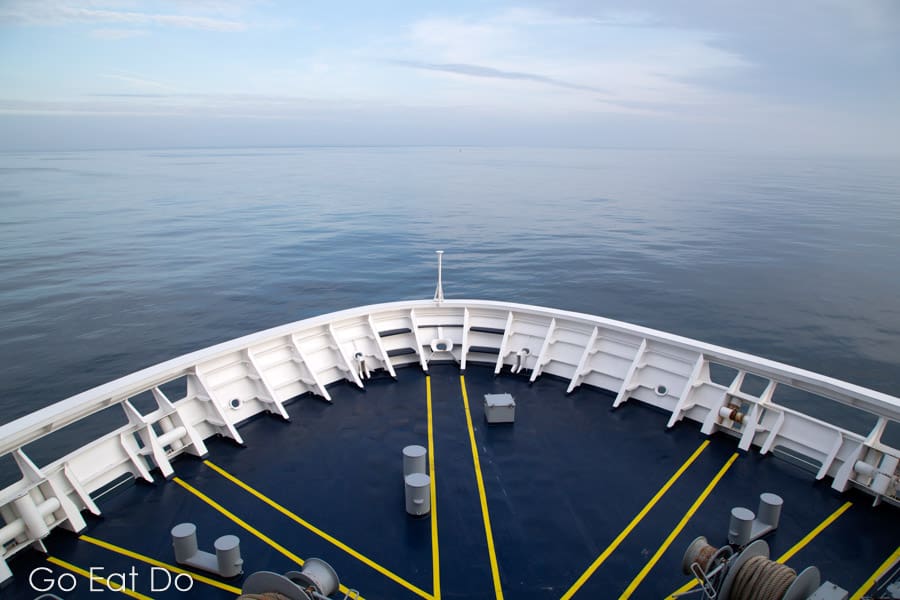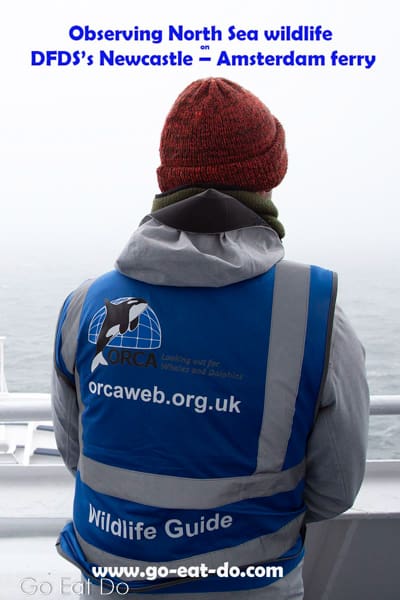Stuart Forster reports on observing North Sea wildlife on DFDS’s Newcastle – Amsterdam ferry with a wildlife officer from ORCA, a charity dedicated to studying and protecting whales, dolphins and porpoises.
Minke whales have been spotted on sailings of the Princess Seaways every day over the past week. White-beaked dolphins and harbour porpoises are also commonly seen from DFDS ships crossing the North Sea between the Port of Tyne and Ijmuiden.
Disclosure: Some of the links below and banners are affiliate links, meaning, at no additional cost to you, I will earn a commission if you click through and make a purchase.
ORCA on DFDS ferries
I glean that information from Alex, a wildlife officer from the ORCA, while fellow passengers file into the room we’re in at the front of the ferry. He’s due to give a presentation about North Sea wildlife. Afterwards, we’ll head onto the deck and use binoculars to see what we can spot while heading away from the Dutch coast.
During 2018, 35,000 people participated in the presentations and wildlife viewing sessions organised by ORCA on DFDS ferries sailing on the Newcastle – Amsterdam route. Volunteers from ORCA participate in gathering data about cetaceans — the collective term for whales, dolphins and porpoises — on this and other routes. The data is analysed and published as part of annual reports entitled The State of European Cetaceans.
Around 90 species of cetaceans inhabit the world. Around a third of them swim in European waters. North Sea bottlenose dolphins grow to around four metres in length. Common seals and harbour seals also count among the marine mammals inhabiting the body of water we’re sailing on.
Alex explains that much of the North Sea is relatively shallow. That’s why blue whales are rarely seen here. The world’s biggest animal grows to lengths of up to 33 metres. We’re sailing in an area where the seafloor is around 25 metres below us. Blue whales frequently dive hundreds of metres below the surface; something that would only be possible in deep trenches off Norway.
We hear how cetaceans are classified into two groups, according to whether they have teeth. Toothed cetaceans have one blow hole and a smooth back with a dorsal fin halfway along. Those without teeth eat by filtering krill, small crustaceans and fish in baleen plates made from keratin — the substance that forms our fingernails and hair. Those with baleen have two blowholes and bumpy backs with a dorsal fin about two-thirds of the way along.

How to spot a whale
All cetaceans are mammals, not fish, and breathe air after coming to the water’s surface. The water vapour they exhale on surfacing shoots into the air. The cloud reaches up to eight metres high in the case of fin whales — one of which was spotted in the North Sea during 2017. The blow is one of the best ways of spotting the presence of cetaceans.
Sometimes gannets and diving seabirds help give away the location of cetaceans swimming close to schools of fish. On calm days the dark shape of a body gliding beneath the surface may be enough to pinpoint a whale.
A humpback was spotted off Newcastle in 2019. One orca was seen in 2018. Minkes are sighted frequently. I’m probably not the only passenger hoping for a repeat when Alex says he saw a pod of eight white-beaked dolphins a few days ago.

Threats beneath the waves
Alex does not confine his presentation only to cetaceans. He chats about phytoplankton; microscopic organisms, at the bottom of the food chain, that convert carbon dioxide to oxygen. He also informs us that the sea we’re sailing on provides habitat to hard corals.
Climate change, which involves the warming of the world’s oceans, is causing a habitat shift among marine wildlife. Warm water species are heading north seeking cool water. Those that prefer cool water are heading towards the poles.
Along with pollution, we hear that climate change is a risk to the welfare of cetaceans. Marine litter, including plastics that have been ingested, is causing whales and other marine animals to die.
Other than that, the creatures run the risk of being struck and injured while at the water’s surface in busy shipping lanes.
The presentation ends with Alex explaining how we can join ORCA and participate in collecting data about whales, dolphins and porpoises.
Several of us follow the wildlife officer outside, onto the deck. We sign for binoculars and stare for signs of life on the sea.

Further information
Visit the ORCA website to find out more about the charity, what it does and how to get involved.
You can help protect marine wildlife by reducing plastic waste and properly disposing of litter such as plastic bags and bottles.
DFDS operates daily sailings between the Port of Tyne near Newcastle and Ijmuiden near Amsterdam:
I sailed between Newcastle and Amsterdam in mid-May. I spotted a pod of porpoises and several seabirds but missed the sighting of a minke whale because I went to get a coffee.
The photos illustrating this post are by Why Eye Photography. Why Eye Photography is based in North East England. If you have a project that you’d like to have photographed, please call 07947 587136 to discuss your requirements.
If you enjoyed this post about observing North Sea wildlife on DFDS’s Newcastle – Amsterdam ferry why not sign up for the free Go Eat Do newsletter? It’s a hassle-free way of getting links to posts on a monthly basis.
‘Like’ the Go Eat Do Facebook page to see more photos and content.




Sharon James
August 8, 2019 at 23:17I thought you had to visit South Africa or Canada to see whales!!! This is something for our bucket list.
Stuart Forster
August 12, 2019 at 11:45Isn’t it great that it’s possible to see cetaceans in the North Sea. The wildlife officer was incredibly knowledgeable.